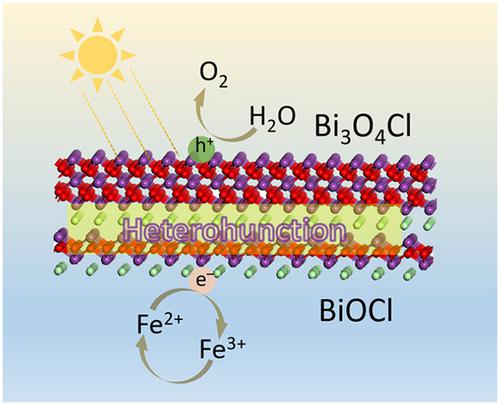Our official English website, www.x-mol.net, welcomes your
feedback! (Note: you will need to create a separate account there.)
Reconstructing Dual‐Induced {0 0 1} Facets Bismuth Oxychloride Nanosheets Heterostructures: An Effective Strategy to Promote Photocatalytic Oxygen Evolution
Solar RRL ( IF 6.0 ) Pub Date : 2019-03-28 , DOI: 10.1002/solr.201900059 Shangbo Ning 1, 2 , Xiaoqi Shi 1 , Hongwen Zhang 1 , Huaxiang Lin 1 , Zizhong Zhang 1 , Jinlin Long 1 , Yi Li 1 , Xuxu Wang 1
Solar RRL ( IF 6.0 ) Pub Date : 2019-03-28 , DOI: 10.1002/solr.201900059 Shangbo Ning 1, 2 , Xiaoqi Shi 1 , Hongwen Zhang 1 , Huaxiang Lin 1 , Zizhong Zhang 1 , Jinlin Long 1 , Yi Li 1 , Xuxu Wang 1
Affiliation

|
Sunlight‐driven photocatalytic water splitting to generate oxygen (O2) is a promising approach for utilizing solar energy. Herein, direct Z‐scheme heterostructure photocatalysts composed of ultrathin Bi3O4Cl and BiOCl nanosheets are rationally fabricated via alkaline chemical etching and solvent exfoliation for O2 evolution under visible light. With AgNO3 and FeCl3 as the electron scavenger, the optimized ultrathin Bi3O4Cl/BiOCl exhibits prominent photocatalytic activity for O2 production under visible‐light illumination and the production rate (Fe3+: 58.6 µmol g−1 h−1) is much higher than the nanocrystal heterostructure (Fe3+: 28.5 µmol g−1 h−1). This ultrathin heterostructure system can efficiently transfer the electrons, which leads to a considerable improvement in the photocatalytic performance. Due to the suitable band edge potentials and the intense electronic interaction between two‐dimensional (2D) Bi3O4Cl and 2D BiOCl, as confirmed by theoretical computations, photoluminescence, and photoelectricity tests, the ultrathin heterojunction with an internal electric field has a highly remarkable charge transfer. The intimate interface contact and {0 0 1} facets effect promote the high photocatalytic performance of the ultrathin Bi3O4Cl/BiOCl heterostructure.
中文翻译:

重建双重诱导的{0 0 1}晶面氯氧化铋纳米片异质结构:促进光催化氧逸出的有效策略
阳光驱动的光催化水分解产生氧气(O 2)是一种利用太阳能的有前途的方法。在此,通过碱性化学刻蚀和溶剂剥离法合理地制造了由超薄Bi 3 O 4 Cl和BiOCl纳米片组成的直接Z型异质结构光催化剂,以在可见光下释放O 2。以AgNO 3和FeCl 3为电子清除剂,优化后的超薄Bi 3 O 4 Cl / BiOCl在可见光照射下对O 2的产生具有显着的光催化活性,并且生产率高(Fe 3+:58.6 µmol g -1 h -1)比纳米晶体异质结构(Fe 3+:28.5 µmol g -1 h -1)高得多。这种超薄异质结构体系可以有效地转移电子,从而大大提高了光催化性能。由于合适的能带边缘电势以及二维(2D)Bi 3 O 4 Cl和2D BiOCl之间的强烈电子相互作用,如理论计算,光致发光和光电测试所证实,具有内部电场的超薄异质结具有一个非常出色的电荷转移。紧密的界面接触和{0 0 1}面效应促进了超薄Bi的高光催化性能3 O 4 Cl / BiOCl异质结构。
更新日期:2019-03-28
中文翻译:

重建双重诱导的{0 0 1}晶面氯氧化铋纳米片异质结构:促进光催化氧逸出的有效策略
阳光驱动的光催化水分解产生氧气(O 2)是一种利用太阳能的有前途的方法。在此,通过碱性化学刻蚀和溶剂剥离法合理地制造了由超薄Bi 3 O 4 Cl和BiOCl纳米片组成的直接Z型异质结构光催化剂,以在可见光下释放O 2。以AgNO 3和FeCl 3为电子清除剂,优化后的超薄Bi 3 O 4 Cl / BiOCl在可见光照射下对O 2的产生具有显着的光催化活性,并且生产率高(Fe 3+:58.6 µmol g -1 h -1)比纳米晶体异质结构(Fe 3+:28.5 µmol g -1 h -1)高得多。这种超薄异质结构体系可以有效地转移电子,从而大大提高了光催化性能。由于合适的能带边缘电势以及二维(2D)Bi 3 O 4 Cl和2D BiOCl之间的强烈电子相互作用,如理论计算,光致发光和光电测试所证实,具有内部电场的超薄异质结具有一个非常出色的电荷转移。紧密的界面接触和{0 0 1}面效应促进了超薄Bi的高光催化性能3 O 4 Cl / BiOCl异质结构。


















































 京公网安备 11010802027423号
京公网安备 11010802027423号